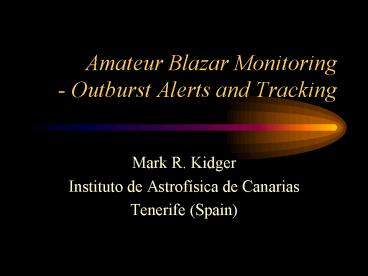Amateur Blazar Monitoring Outburst Alerts and Tracking - PowerPoint PPT Presentation
1 / 14
Title:
Amateur Blazar Monitoring Outburst Alerts and Tracking
Description:
Some interesting quasars are even bright enough to be observed visually. ... In the USA, the AAVSO has various quasars on its programme. ... – PowerPoint PPT presentation
Number of Views:49
Avg rating:3.0/5.0
Title: Amateur Blazar Monitoring Outburst Alerts and Tracking
1
Amateur Blazar Monitoring- Outburst Alerts and
Tracking
- Mark R. Kidger
- Instituto de Astrofísica de Canarias
- Tenerife (Spain)
2
Introduction
- The equipment available to todays amateur is
catching up rapidly with professional
instrumentation. - A good amateur CCD camera performs as well (or
better) than the CCD cameras that were mounted on
large professional telescopes only ?10 years ago. - Excellent software is also available.
3
Introduction
- Amateur astronomers can now use good autoguider
systems, making long exposures easier to obtain. - The combination of the CCDs sensitivity, its
linearity and its on-line software allow amateurs
to carry out observing projects that were, until
recently, the exclusive property of professional
observatories.
4
Introduction
- Good quality deep-sky observations can be
obtained even from bright sites ? useful work can
be done even by observers near big cities. - Some amateurs are reaching magnitudes around 21
with 50-cm class telescopes ? many faint objects
of great interest to professionals can be
observed.
5
Why Quasars?
- An example of a valuable project with a CCD is
quasar monitoring. - There are few observatories carrying out
large-scale monitoring programmes because of the
pressure to close small telescopes. - Many objects are highly variable.
- Space missions are leading to an increasing need
for high-intensity continuous observing campaigns
that require many telescopes.
6
Why Quasars?
- There is a pressing need for observations to be
made with small telescopes. - Amateur observers could fulfil this need as they
are distributed all around the world (unlike
major observatories!) and have constant access to
their telescopes. - Some amateur observers are already producing
excellent and valuable data.
7
Who and how?
- Some interesting quasars are even bright enough
to be observed visually. - In the U.K., the B.A.A.V.S.S. and the The
Astronomer Group routinely observe several
quasars visually. - In the USA, the AAVSO has various quasars on its
programme. - A few amateurs (e.g. Paul Boltwood, in Canada)
already take routine CCD data.
8
Visual observations
- Generally limited to V?15
- Errors ?0.2 magnitudes
- Are useful for establishing long-term trends in a
light curve, but not fine detail - Plenty of data and dedication are required
- One observation per month is not enough
- Some objects may vary both quickly and with high
amplitude (0.5 mags. in 1-2 hours).
9
Amateur visual data 3c 66a
- BAA visual data on 3c66a defines its behaviour
over the last two years and shows an important
outburst.
10
Amateur visual data OJ287
- BAA visual data even gives useful inform-ation on
a magnitude 16 object like OJ287. Flares and
outbursts can be clearly detected.
11
Amateur CCD data
- Paul Boltwood is a Canadian amateur living in a
bright site in the suburbs of Ottawa (Canada). - He uses a 5-inch (12.5cm) refractor, with a
home-made CCD and standard VRI filters. - He has successfully tracked AO 0235164 through a
deep minimum when it reached V19.5
12
OJ287 - amateur data was vital
- The OJ-94 project was established to observe the
predicted 1994 outburst of OJ287. - This is the complete light curve at 22 different
wavelengths. - Paul Boltwood supp-lied ?50 of the data.
13
OJ287 - amateur data
- Paul Boltwoods CCD data was vital to the
projects success. - However, even the visual data shows the main
light curve features clearly.
14
What can the amateur do?
- Contribute to monitoring programmes.
- Observe a few objects frequently rather than many
objects just occasionally. - Reduce data quickly.
- Let people know when you see something unusual.
- Monitor faint objects for outbursts
- Let the professionals know when an interesting
object becomes especially bright.































